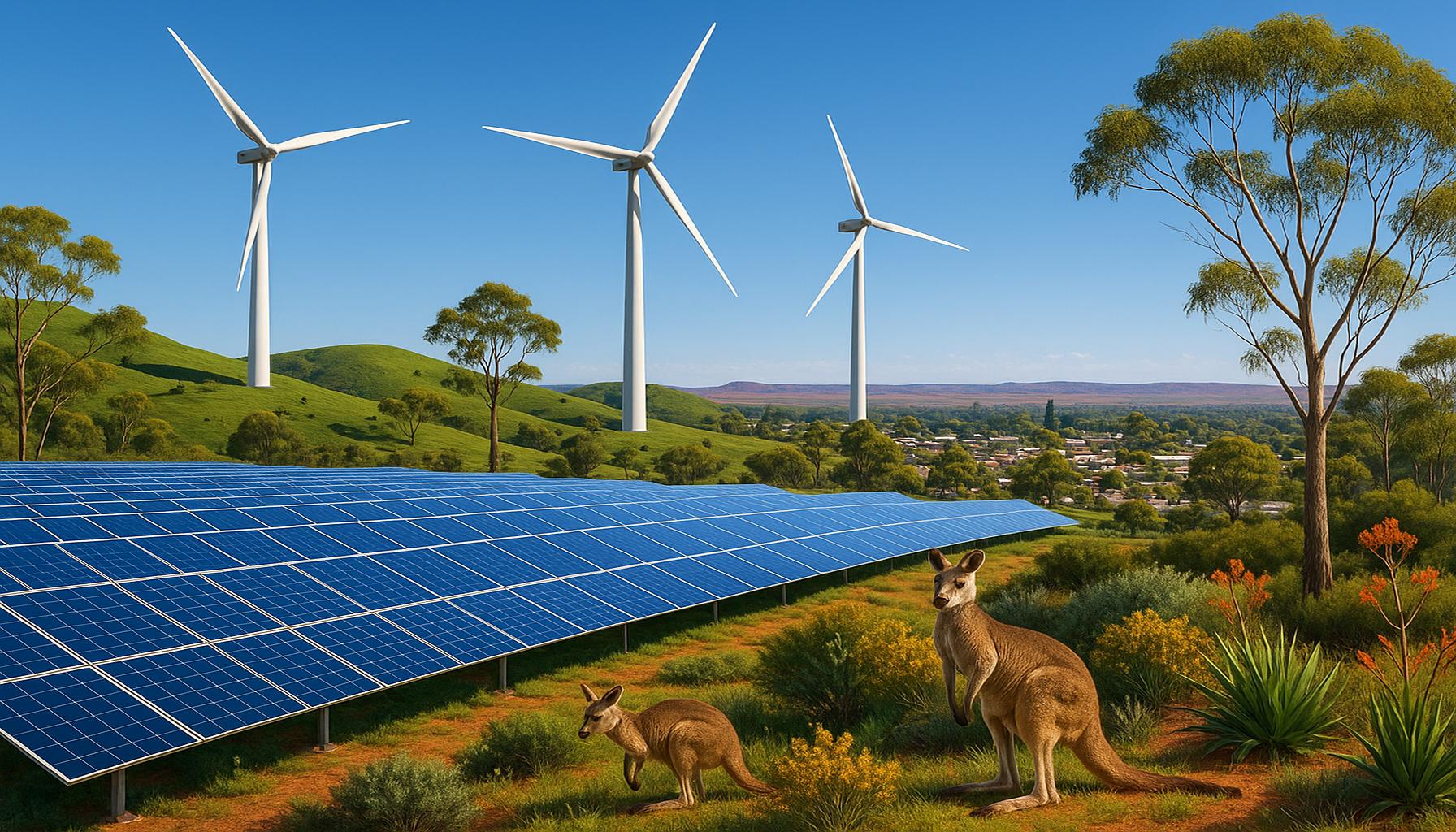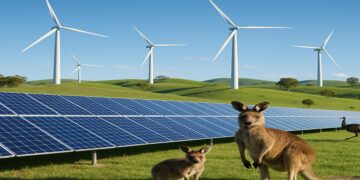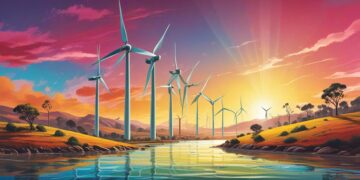How the transition to renewable energy is shaping Australia’s economy

Investment in Renewable Technologies
The shift towards renewable energy in Australia is underpinned by substantial investments in advanced technologies. Both the Australian government and private companies are channeling resources into solar, wind, and hydroelectric power. For instance, Australia has established itself as a global leader in solar energy, boasting one of the highest rates of rooftop solar panel installations per capita in the world. Recent data indicates that over 3 million homes have solar panels, a trend facilitated by government incentives and rebates that promote sustainable energy usage.
Additionally, significant wind farm projects have emerged, particularly in states like South Australia, which has harnessed wind energy to generate more than half of its electricity. These investments not only contribute to reducing carbon emissions but also stimulate technological advancements, making renewable energy sources like solar panels and wind turbines more efficient and cost-effective over time.
Job Creation in Regional Areas
The emergence of a robust renewable energy sector is projected to generate thousands of job opportunities, especially in rural and regional areas. This economic benefit is crucial as these regions often face higher unemployment rates. The construction and maintenance of renewable energy facilities, such as solar farms and wind turbines, require a skilled workforce, thus leading to the training and development of local talent.
- Local Training Programs: Initiatives like the Clean Energy Training Program aim to equip individuals with the necessary skills to work in this evolving sector.
- Indirect Job Growth: The proliferation of renewable energy also spurs ancillary businesses, from manufacturing components to providing maintenance services.
Global Market Competitiveness
Australia’s commitment to embracing clean energy is becoming a competitive advantage in the global market. As countries around the world strive to meet their environmental goals—such as the Paris Agreement—nations rich in renewable resources are increasingly sought after for partnerships and trade. Furthermore, transitioning to renewable energy enhances Australia’s energy security, reducing reliance on fossil fuels, which are subject to volatile price fluctuations and geopolitical tensions.
The renewable sector’s growth systematically influences various economic indicators. As clean technologies mature, the cost of energy is expected to decrease, benefiting consumers and businesses alike. Additionally, the rising demand for green products can lead to expanded export opportunities for Australian companies, particularly in the Asia-Pacific region.
Conclusion
Australia’s transition towards renewable energy is multifaceted and holds significant implications for its economic landscape. By investing in technology, creating jobs, and enhancing global competitiveness, the nation is laying the groundwork for a sustainable future. However, as the country navigates this transformation, it is crucial to address the challenges that accompany these changes, ensuring that all Australians benefit from a green economy.
CHECK OUT: Click here to explore more
Modernization of Infrastructure
The transition to renewable energy is not solely focused on the adoption of alternative energy sources but also necessitates a profound modernization of Australia’s energy infrastructure. This modernization involves significant investments in cutting-edge technologies, predominantly smart grid systems and advanced energy storage solutions, both of which play a crucial role in facilitating the country’s shift towards a more sustainable energy paradigm.
Developing a smart grid contributes significantly to optimally managing energy supply and demand. By incorporating digital communication technology into the electricity distribution network, smart grids enhance the reliability and efficiency of electricity transmission across Australia. These systems enable real-time data collection and analysis, allowing for dynamic adjustments in energy flow based on consumption patterns. For example, during peak usage hours, the grid can prioritize energy distribution to high-demand areas, reducing the likelihood of blackouts and ensuring that electricity reaches those who need it most.
Additionally, advancements in battery technology, especially lithium-ion batteries, are driving the integration of renewable energy sources. These innovations enable the storage of excess energy generated during optimal solar or wind conditions, which can then be utilized when demand levels exceed generation. Australia, with its abundance of sunlight, has made strides in harnessing solar energy, and large-scale battery systems, like the Hornsdale Power Reserve in South Australia, have become pivotal in stabilizing the national grid. This facility alone has a capacity of 150 megawatts, showcasing the substantial impact of effective energy storage solutions in managing intermittent energy sources.
Key Infrastructure Initiatives:
- Smart Grids: Programs designed to digitize the electricity distribution network, optimizing energy flow and minimizing losses through real-time monitoring and control.
- Energy Storage Solutions: The development of diverse energy storage technologies, including pumped hydro, compressed air, and advanced battery systems to ensure consistent delivery of renewable energy to consumers.
- Transmission Upgrades: Necessary enhancements to existing transmission lines to efficiently handle increased energy flows from remote renewable generation sites to urban centers.
These strategic infrastructure changes not only enable the increased adoption of renewable energy but also stimulate the economy significantly. The construction, upgrading, and continual maintenance of energy infrastructure necessitate considerable capital investment, leading to extensive job creation. Studies suggest that every additional megawatt of new renewable energy capacity could generate approximately 3.5 jobs directly related to the construction phase, with further employment opportunities arising from the ongoing maintenance and operation of renewable facilities.
Moreover, as these infrastructure projects progress, they contribute to broader economic revitalization efforts. Regions involved in manufacturing components for renewable energy initiatives—such as wind turbines, inverters, and solar panels—are witnessing marked economic improvements. This local manufacturing not only supports regional economies but also reduces Australia’s dependence on imported energy technologies, thereby enhancing national energy security.
Ultimately, updating and enhancing energy infrastructure will significantly improve Australia’s ability to meet domestic energy demands while establishing a strong foothold in renewable technology exports. This innovative shift, along with the creation of new industry standards, underscores Australia’s commitment to evolving into a global leader in clean energy production and sustainable practices.
SEE ALSO: Click here to read another article
Investment Opportunities and Economic Growth
The transition to renewable energy is generating substantial investment opportunities that are currently reshaping Australia’s economy. As the nation commits to reducing carbon emissions and enhancing sustainability, both government and private sector investments are being directed towards renewable energy projects, research, and development. This influx of financial resources is not only accelerating the shift towards cleaner energy but also fuelling economic growth across multiple sectors.
In recent years, Australia has seen an exponential increase in the deployment of renewable energy technologies. According to the Clean Energy Council, more than 30% of Australia’s electricity is now sourced from renewable sources, with projections indicating this figure could rise to 50% by 2030. This significant shift has attracted investments from both domestic and international stakeholders looking to capitalize on Australia’s abundant natural resources—particularly solar and wind energy. Major international players, such as Tesla and French energy giant ENGIE, have already made substantial investments in the Australian energy sector, demonstrating the growing global interest in the country’s renewable potential.
Government Incentives and Public Funding
To further stimulate investment, the Australian government has introduced various incentives aimed at attracting both private and public capital. Programs such as the Renewable Energy Target (RET) provide financial mechanisms for businesses and households to invest in solar panel installations and other renewable technologies. Additionally, the National Green Energy Fund supports innovative projects aimed at augmenting the uptake of renewable energy solutions across the nation.
Moreover, several state governments are also spearheading initiatives that promote renewable energy investments. For example, the New South Wales government has proposed a $32 billion plan to transform the grid and introduce more renewable sources, thereby enhancing energy security and flexibility. These government-led initiatives not only create a favorable investment climate but also drive regional economic development through job creation and increased local manufacturing.
Job Creation and Workforce Development
The shift to renewable energy is acting as a catalyst for “green” job creation, which is vital for revitalizing the Australian labor market. The transition is projected to create around 50,000 new jobs by 2025, particularly in areas such as solar installation, battery manufacturing, and other clean technologies. The focus on upskilling the workforce is critical, with training programs being established to equip workers with the necessary skills to thrive in the evolving energy landscape. Collaborations between educational institutions, government, and industry are paving the way for comprehensive workforce development to meet the growing demand for skilled labor in the renewable sector.
Furthermore, as local industries gear up for the energy transition, the burgeoning sector of sustainable technologies is expected to provide new employment opportunities across various fields, including engineering, policy development, and environmental management. By fostering innovation and encouraging the growth of green startups, Australia is positioning itself as a frontrunner in the global renewable energy market.
These multifaceted impacts of the renewable energy transition are not only enhancing the Australian economy but are also contributing to improved environmental outcomes through reduced greenhouse gas emissions. The combination of increased investment, job creation, and technological advancement is paving the way for a more resilient and sustainable economy, firmly placing Australia on the path toward a greener future.
CHECK OUT: Click here to explore more
Conclusion
The transition to renewable energy is fundamentally transforming Australia’s economy by fostering sustainable growth, enhancing energy security, and creating a plethora of job opportunities. As Australia commits to a low-carbon future, the increased reliance on renewable energy sources such as solar and wind power is not just an environmental imperative but a pathway to economic revitalization. The government’s proactive stance through initiatives like the Renewable Energy Target and the National Green Energy Fund has successfully attracted both local and international investments, cementing Australia’s position as a global player in the renewable energy sector.
Moreover, the anticipated job creation—estimated at around 50,000 new positions by 2025—reflects the burgeoning demand for skilled labor in sustainable technologies. This shift not only revitalizes the labor market but also underscores the importance of workforce development initiatives designed to equip Australians with essential skills for the future. As collaborations between educational institutions and industry continue to strengthen, the potential for innovation and local manufacturing grows, further contributing to economic resilience.
In conclusion, the move towards renewable energy represents a distinctive opportunity for Australia to lead in the global clean energy landscape while simultaneously benefiting its economy. By embracing this transition, Australia is positioning itself for a prosperous and sustainable future, one that balances both economic growth and environmental stewardship, ultimately paving the way for a transformative era for the Australian economy.

Beatriz Johnson is a seasoned financial analyst and writer with a passion for simplifying the complexities of economics and finance. With over a decade of experience in the industry, she specializes in topics like personal finance, investment strategies, and global economic trends. Through her work, Beatriz empowers readers to make informed financial decisions and stay ahead in the ever-changing economic landscape.






